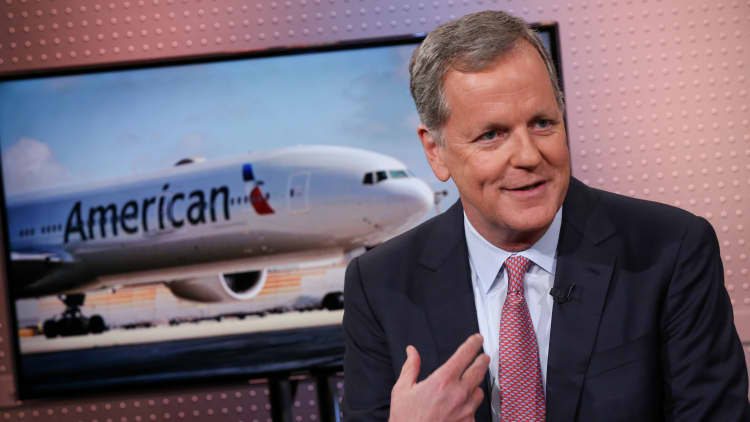
The record drop in air travel demand because of the coronavirus pandemic appears to be as bad as it's going to get, American Airlines CEO Doug Parker said Wednesday.
"It certainly feels like we're at the bottom," Parker told CNBC in an interview. "Our revenues are down 90% on a year-over-year basis and they've been that way now for a few weeks. The real question is how long you stay at the bottom and when do we begin to recover. I don't think I know that better than anybody else."
American and other large U.S. airlines, including Delta, Southwest and JetBlue on Tuesday announced agreements with the Treasury Department on the terms for their share of $25 billion in government grants and low-interest loans.
But despite the aid, airline executives have painted a bleak picture for their businesses, warning that travel demand has all but evaporated, sapping cash from the airlines as they continue to pay fixed costs with the fewest passengers in decades taking to the skies.
American said the Treasury Department approved $5.8 billion in assistance — a $4.1 billion grant and a $1.7 billion low-interest loan. The Fort Worth, Texas-based carrier said it plans to apply for another government loan of around $4.75 billion.
United Airlines on Wednesday said it expects to receive $5 billion in government coronavirus relief — $3.5 billion as grants and $1.5 billion as a low-interest loan — to help it through a sharp drop in demand because of the disease.
CEO Oscar Munoz and President Scott Kirby, who takes the reins next month, told staff that the aid is not enough to cover its full payroll expense, but that the carrier will not furlough or cut the pay rates of U.S. employees through Sept. 30, a condition of the aid.
"But the challenging economic outlook means we have some tough decisions ahead as we plan for our airline, and our overall workforce, to be smaller than it is today, starting as early as October 1," Munoz and Kirby said.
The Chicago-based airline is planning even deeper cuts to its network in the coming months. In the first two weeks of April the airline flew 200,000 people, a 97% drop compared with the same period in 2019. "And we expect to fly fewer people during the entire month of May than we did on a single day in May 2019," the executives wrote.
The executives predicted travel demand won't come back quickly, weakness that will likely last the rest of the year and into 2021 because of the economic toll and lingering health concerns.
American Airlines' Parker said it isn't yet clear when travelers will return en masse, but that some encouraging signs are emerging such as an uptick in bookings for more than three months away and some reservations for corporate events in the fourth quarter.
"There are indications that the world is ready to start traveling again but they're very preliminary and it's certainly not happening today," he said. "Whenever people are prepared to start traveling again our team's going to be in place and ready to take care of them."
Parker added that the airline is not planning to defer new aircraft orders, such as the Boeing 737 Max, which is still grounded after two fatal crashes, but American will retire older aircraft such as Boeing 757s and 767s earlier than planned.
"The new airplanes that are scheduled to come, we want," he said. "We don't have any intention of working with the manufacturers to defer or cancel those orders."


